
by Oleg
Artamonov
11/21/2006 | 03:51 PM
The more brands come to the PSU market and the tougher the competition becomes, the wider various marketing inventions are employed besides just technical advances and innovations.
Unfortunately, besides experimenting with colorful box designs and accessories (well, it’s hard to expand a PSU’s accessories set beyond the customary set of a cable, a couple of braces, and a handful of stickers), the marketing department comes up with a technical lingo to bewilder the customer with mysterious terms and abbreviations. Every box and instruction shows a long list of employed technologies, the point of some of which may be distorted almost to the opposite.
That’s why I’m going to walk you through some of the technologies (or what the PSU manufacturers regard as such) most frequently mentioned on boxes with modern power supplies. And then I’ll put PSUs with such technologies to practical tests.
In good old times PC power supplies used to have one power rail for each of the output voltages (+5V, +12V, +3.3V, and a couple of negative voltages), and the maximum output power on each of the rails was not higher than 150-200W. It’s only in some high-wattage server-oriented power supplies that the load on the +5V rail could be as high as 50A, i.e. 250W. This situation was changing as computers required ever more power and the distribution of power consumption among the different power rails was shifting towards +12V.
The ATX12V 1.3 standard recommends a max current of 18A for the +12V rail and this is where a problem occurred. It was about safety regulations rather than about increasing the current load further. According to the EN-60950 standard, the maximum output power on user-accessible connectors must not exceed 240VA. It is thought that higher output power may with a higher probability lead to various disasters like inflammation in case of a short circuit or hardware failure. Obviously, this output power is achieved on the +12V rail at a current of 20A while the PSU connectors are surely user-accessible.
So, when it became necessary to push the allowable current bar higher on the +12V rail, Intel Corporation, the developer of the ATX12V standard, decided to divide that power rail into multiple ones, with a current of 18A on each, the 2A difference being left as a small reserve. Purely out of safety considerations, there was no other reason for that solution. It means that the power supply does not necessarily have to have more than one +12V power rail. It is only required that an attempt to put a load higher than 18A on any of its 12V connectors would trigger off the overcurrent protection. That’s all. This simplest way to implement this is to install a few shunts into the PSU, each of which is responsible for a group of connectors. If there’s a current of over 18A on a shunt, the protection wakes up. As a result, the output power of none of the 12V connectors can exceed 18A*12V=216VA, but the combined power on the different 12V connectors can be higher than that number.
That’s why there are virtually no power supplies existing with two, three or four +12V power rails. Why should the engineer pack additional components into the already overcrowded PSU case when he can do with just a couple of shunts and a simple chip that will be controlling the voltage in them (the resistance of a shunt being a known value, the current passing through the shunt can be known if you know the voltage).
But the marketing folk just couldn’t pass by such an opportunity and now you can read on any PSU box that dual +12V output circuits help increase power and stability, the more so if there are not two but three such lines!
You think they stopped at that? Not at all. The latest trend is power supplies that have and don’t have the splitting of the +12V rail at the same time. How? It’s simple. If the current on any of the +12V output lines exceeds the 18A threshold, the overcurrent protection becomes disabled. As a result, they can still embellish the box with the magical text, “Triple 12V Rails for Unprecedented Power and Stability”, but can also add there some nonsense that the three rails are united into one when necessary. I call this nonsense because, as I have written above, there have never been separate +12V power rails. It’s impossible to comprehend the depth of that “new technology” from a technical standpoint. In fact, they try to present the lack of one technology as another technology.
As far as I know, the “self-disabling protection” is currently being promoted by Topower and Seasonic and, accordingly, by the companies that are selling such PSUs under their own brands.
This means that the speed of the PSU fan is varied depending on temperature or, less often, on load power. This speed management is currently implemented in all PSUs, even cheapest ones, so the question is about the quality of implementation. This quality can be viewed from three aspects: the quality of the employed fan, the minimum speed of the fan, and the speed adjustment range. For example, simplest power supplies may have speed management, but the speed is changed from 2500rpm at a 50W load to 2700rpm at a 350W load. It’s like the speed doesn’t change at all.

Respectable manufacturers implement the fan speed management system properly, but often play another marketing trick. The fan speed (or the noise level) they write into the power supply specs is measured at a temperature of 18°C as reported by a sensor inside the PSU. This thermal sensor is usually installed somewhere in the hottest part of the PSU, on the heatsink with diode packs, so you can only have that temperature in reality if you put your PSU in a refrigerator. Although no one keeps PSUs in a fridge, the specification still contains an unrealistically pretty number like a noise level of 16dBA (this is quieter than the background noise in a quiet room). In reality, the room temperature is usually within 20-25°C, and the temperature inside the PC case is closer to 30°C. Of course, you can’t get 16dBA under such conditions.
Short circuit protection is obligatory according to the ATX12V Power Supply Design Guide. This means that it is implemented in all power supplies, even those that don’t explicitly mention such protection, that claim to comply with that standard.
This protects the power supply from overload on all of its outputs combined. This protection is obligatory.
This protects the separate PSU outputs from overload (but not yet from short circuit). It is available on many, but not all, PSUs, and not for all of the outputs. This protection is not obligatory.
This protects the PSU from overheat. It is not required and is not implemented often.
This protection is obligatory, but is only meant for critical failures. It works only when some output voltage shoots 20-25% above the nominal value. In other words, if your power supply yields 13V instead of 12V, you must replace it as soon as possible, but its protection is not required to react yet because it is designed for even more critical situations.
As opposed to too-high voltage, too-low voltage cannot do much harm to your computer, but may cause failures in operation of the hard drive, for example. This protection works when a voltage bottoms out by 20-25%.
Soft braided nylon tubes on the PSU’s output cables help lay them out neatly inside the system case.
Unfortunately, many manufacturers have switched from the undoubtedly good idea of using nylon sleeves to the use of thick plastic tubes, often screened and covered with a paint that shines in ultraviolet. The shining paint is a matter of personal taste, of course, but the screening does not do anything good to the PSU cables. The thick tubes make the cables stiff and unwilling to bend, which makes it hard to lay them out in the system case properly and is even dangerous for the power connectors that have to bear the pressure of the cables that resist the bending.
This is often advertised as a means to improve the cooling of the system case, but I can assure you that the tubes on the power cables have but a very small effect on the airflows inside your computer.
The AC electric mains can be considered as having two types of power: active and reactive. Reactive power is generated in two cases: when the load current and the mains voltage are out of phase (that is, the load is inductive or capacitive) or when the load is non-linear. The PC power supply is a pronounced example of the second case. It will normally consume the mains current in short high impulses that coincide with the maximums of the mains voltage.
The problem is that while active power is fully transformed into useful work in the load, reactive power is not consumed at all. It is driven back into the mains. It is kind of wandering to and fro between the generator and the load, but it heats up the connecting wires as well as active power does. That’s why reactive power must be got rid of.
The circuit called active PFC is the most efficient way to suppress reactive power. It is in fact an impulse transformer that is designed in such a way that its instantaneous consumed power is directly proportional to the instantaneous voltage in the mains. In other words, it is made linear on purpose and thus consumes active power only. The voltage from the output of the active PFC device goes right to the switching transformer of the power supply which used to be a reactive load due to its non-linearity. But now that it receives direct voltage, the non-linearity of the second transformer doesn’t matter anymore because it is detached from the electric mains and cannot affect it.
The power factor is the measure of reactive power. It is the ratio of active power to the total of active and reactive power. It is about 0.65 with an ordinary PSU, but PSUs with active PFC have a power factor of 0.97-0.99. So, the active PFC device reduces reactive power almost to zero.
Users and even hardware reviewers sometimes make no difference between the power factor and the efficiency factor. Although both these terms describe the effectiveness of a power supply, it is a gross mistake to confuse them. The power factor describes how efficiently the PSU uses the AC electric mains, i.e. what percent of power the PSU consumes from it is actually put to good use. The efficiency factor describes how efficiently this consumed power is transformed into useful work. There is no connection between these two things because, as I said above, reactive power, which determines the value of the power factor, is not transformed in the PSU into anything. You cannot apply the term “conversion efficiency” to it, so it has no effect on the efficiency factor.
Generally speaking, it is the power supply companies rather than the users that profit from active PFC because it reduces the computer’s load on the electric mains by over one third. And this amounts to big numbers today when there is a PC standing on every office desk. From an ordinary user’s point of view, active PFC makes no difference even when it comes to electricity bills. Home electricity supply meters measure only active power as yet. The manufacturers’ claims that active PFC can in any way help your computer are nothing but marketing noise.
A side effect of active PFC is that it can be easily designed to support a full range of input voltages, from 90 to 260V, thus making it a universal PSU that can work in any power grid without a manual selection of the input voltage. Moreover, PSUs with manual switches can only work in two input voltage ranges, 90-130V and 180-260V, and you cannot start them up at an input voltage of 130-180V. A PSU with active PFC covers all those input voltage ranges without any gaps. So, if you have to work in an environment with unstable energy supply, when the AC voltage may often bottom out to below 180V, a PSU with active PFC will allow you to do without a UPS or will make the UPS’ battery life much longer.
Well, the availability of active PFC does not guarantee that the PSU will support the whole range of input voltages. It can be designed to support a range of 180-260V only. This is sometimes implemented in PSUs to be sold in Europe because the use of such narrow-range active PFC helps reduce the manufacturing cost of the PSU somewhat.
Active PFC is not an obligatory feature right now, but from the next year a power supply will have to have a power factor that can only be achieved with active PFC to pass the Energy Star certification (which is voluntary, though).
Passive PFC is the simplest way to correct the power factor. It is a small choke connected in series with the power supply. Its inductance is smoothing out the pulsation of the current consumed by the PSU and is thus reducing the level of non-linearity. There is a very small effect from passive PFC – the power factor grows only from 0.65 to 0.7-0.75. But while implementing active PFC requires a deep redesign of the PSU’s high-voltage circuitry, passive PFC can be easily added into any existing power supply.
Right now it is obligatory for PSUs selling in Europe to have passive PFC. Power supplies with passive PFC with eventually be replaced with active-PFC models.
Efficiency is the ratio of input power to output power. The higher the efficiency of a PSU is, the less heat it generates and the quieter its cooling can be made. Your electricity bills will be lower if the efficiency is high, too.
The current version of the ATX12V 2.2 standard limits the PSU efficiency from below: a minimum of 72% at typical load, 70% at full load and 65% at low load. Besides that, there are optional numbers (an efficiency of 80% at nominal load) and the voluntary certification program “80 Plus” which requires that the PSU has an efficiency of 80% and higher at loads from 20% to maximum. The new Energy Star certification program to come to effect in 2007 will have the same requirements as in the 80 Plus.
The efficiency of a PSU depends on the input voltage. The higher that voltage is, the better the efficiency. The difference in efficiency between the 110V and 220V power grids is about 2%. Moreover, different samples of the same PSU model may vary in efficiency by 1-2% due to the variations in the parameters of the components employed.
This is nothing but a pretty-looking label. Dual-core processors do not require any special support from the power supply.
Yet another pretty-looking label that means two power connectors for graphics cards and an ability to yield as much power as is considered sufficient for a SLI graphics subsystem. Nothing else stands behind that label.
One more pretty-looking sticker! Industrial class components are components that can work in a very wide range of temperatures. But what’s the purpose of installing a chip capable of working under -45°C into a PSU if this PSU will never be used in such cold weather?
Sometimes the term industrial class components refers to capacitors meant for operation under a temperature up to 105°C, but that’s all clear here, too. The capacitors in the PSU’s output circuits heat up by themselves and also located very close to the hot chokes are always rated for a temperature of 105°C max or their service life would be too short. Of course, there is a much lower temperature inside the PSU, but the problem is that the service life of a capacitor depends on the ambient temperature. Capacitors rated for higher max temperatures are going to last longer under the same thermal conditions.
The input high-voltage capacitors work almost at the temperature of the ambient air, so the use of somewhat cheaper 85°C capacitors there doesn’t affect the PSU’s service life much.
Alluring the potential customer with mysterious terms is a favorite trick of the marketing department.
Here, the term means the topology of the PSU, i.e. the general concept of its circuit design. There are quite a number of different topologies. Besides the double forward converter, PC power supplies may use a forward converter or a half-bridge converter. These terms are only interesting for a specialist and don’t mean much for an ordinary user.
The choice of the particular PSU topology is determined by a number of reasons like the availability and price of transistors with required characteristics (they differ greatly depending on the topology), transformers, controller chips, etc. For example, the single-transistor forward converter is simple and cheap but requires a high-voltage transistor and high-voltage diodes on the PSU output, so it is only used in inexpensive low-wattage models (high-voltage diodes and transistors of high power are too expensive). The half-bridge converter is somewhat more complex, but has a two times lower voltage on the transistors. So, this is generally a matter of availability and cost of the necessary components. I can predict, for example, that synchronous rectifiers will be sooner or later used in the secondary circuits of PC power supplies. There’s nothing new in that technology, but it is too expensive as yet and its advantages don’t cover its cost.
This is a new European Union directive that limits the use of certain substances in electronic equipment since July 1, 2006. It restricts the use of lead, mercury, cadmium, hexavalent chromium, and two bromides. For power supplies this mainly means a transition to non-lead solders. Yes, we are all for ecology and against heavy metals, but a too hasty transition to new materials may have unpleasant consequences. You may have heard the story about Fujitsu’s MPG hard drives which would die due to a failure of Cirrus Logic controllers that had a packaging made of some new environment-friendly compound from Sumitomo Bakelite. The elements of the compound facilitated the migration of copper and silver that formed bridges between interconnects inside the chip case. As a result, the chip would fail almost certainly after 1 or 2 years of operation. The compound was abandoned eventually, and the involved companies exchanged lawsuits, but nothing could restore the data that were lost with the hard drives.
Neo HE series power supplies feature the classic cooling solution with a single 80mm fan. I don’t mean that are the only PSUs designed like that, but models with 120mm fans have been prevailing recently because the larger fan can create the same airflow at a lower rotation speed and, accordingly, at a lower noise level. I can’t say why they install 80mm fans into the Neo HE, but Antec positions this model as a quiet power supply and puts an emphasis on its high efficiency (HE = High Efficiency), small amount of generated heat and, as the result, low fan speed. Let’s see if the power supply is up to these claims.
The manufacturer provided us with a revision A3.1 unit whereas the latest revision is A4. The older revisions of this power supply do not work with some mainboards. You can read the revision number from the white paper sticker on the PSU.
There is an UL certificate number on the PSU, E104405. This helps identify its actual manufacturer, Seasonic.
The component layout and circuit design of the power supply are classic. There are no surprises for me here. The PSU is equipped with active PFC (its choke can be seen in the photo peeping out from under the left heatsink).
The heatsinks are large, with well-developed ribbing. A small additional card with output connectors is fastened on the rear panel of the case. Most of the connectors are detachable.
The PSU has six same-type 6-pin connectors. It doesn’t matter which exactly connector you attach a cable to since they are all identical. On one hand, this guarantees that there will be no user mistakes at connection, but on the other hand, it would be logical to make two separate connectors for top-end graphics cards in which all the pins would be +12V and “ground”.
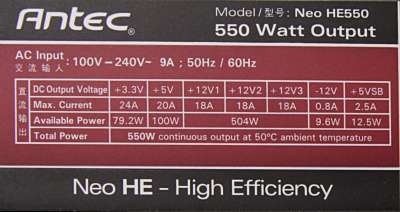
The PSU complies with the ATX12V 2.0 standard, offering three +12V lines with an allowable current of 18A on each, but the combined load current must not be higher than 42A, i.e. 14A on each line. These are “virtual” lines of course. I mean that there is actually only one power rail with a load capacity of 42A inside the PSU, but it is split into three output lines with a current limitation at 18A on each.
Among other matters worth mentioning, there is the ability to work with input voltages from 100 to 240V without manual switching. The full output power of the PSU is declared to be 550W at an ambient air temperature of 50°C. The latter feature is in fact a requirement of the ATX12V Power Supply Design Guide, but many PSU manufacturers neglect it, specifying output power at a lower temperature.
The PSU is equipped with the following cables and connectors:
The following is enclosed with the power supply:
When the power supply was working in pair with an APC SmartUPS SC 620, the UPS overload indicator would turn on at a load of over 350W irrespective of the power source (electric mains or batteries). The switching-over to the batteries was performed without problems.
The first problem with the Neo HE was that it only started up at a second attempt. Our testbed wakes the PSU up as an ordinary PC does, i.e. by sending a low-level signal to the PS_ON contact (it’s the green wire, usually) of the PSU connector. The Neo HE didn’t react at all to my first press on the Power button, but would start up normally on a second press. This didn’t depend on whether the load on the PSU was zero or other at the moment of my trying to turn it on.
The second problem was about the pulsation of the output voltages. It looks normal at first sight:
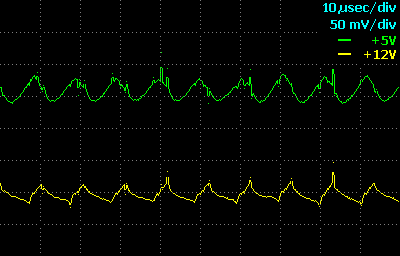
At a load of 550W the output voltage ripple was 38 millivolts on the +5V rail, 31 millivolts on the +12V rail and 32 millivolts on the +3.3V rail, but the amplitude would occasionally jump up so high that I began to suspect some problem with our testbed. However, there were no problems with the High Power HPC560-A12S and the OCZ OCZGXS700 that were tested right before and after the Neo HE, so I threw my suspicions away. The testbed couldn’t have had something against products from the Antec brand only. Moreover, the surges of voltage didn’t vanish at lower loads, although their amplitude and duration diminished proportionally (the voltage ripple fitted into the requirements of the ATX standard at a load of 250W and lower). The oscillogram with a 1ms/div time base, recorded under a load of 400W, shows one such surge. It lasted for about 6 milliseconds and had an amplitude of about 100 millivolts on the +5V rail (to remind you: the allowable maximum is 50 millivolts).
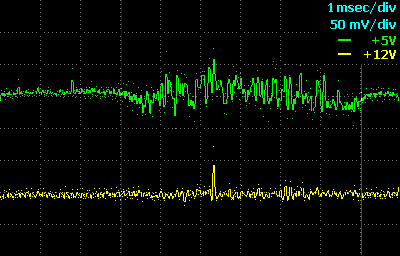
It would go beyond the scope of this review to analyze the circuit design of the PSU to find the reason for the described phenomenon. So, I only have to say that the stability of the revision A3.1 Antec Neo HE 550 calls for improvement. Perhaps I was testing a defective sample, but recalling the forum discussions concerning incompatibility of some mainboards with the revisions lower than A4, I’m inclined to think that that is a common problem, not a single instance.
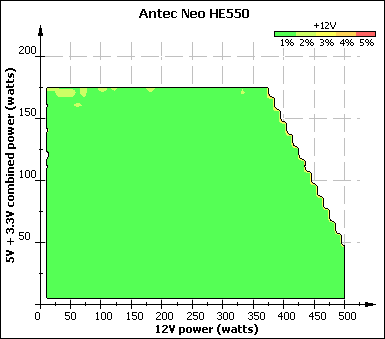
The output voltages proved to be very stable irrespective of the load on the power supply. The Neo HE features a superbly implemented independent regulation of all the three voltages.
The PSU is cooled with a single 80mm Adda AD0812HB-A71GL fan whose speed is adjusted linearly depending on the temperature.
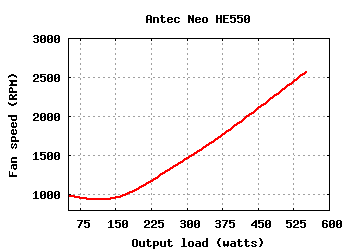
The PSU is really quiet. The fan speed is just a little higher than 2500rpm even at full load. In a load range typical of a modern computer (i.e. below 300W), the PSU is altogether silent.
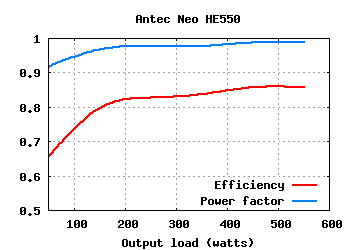
Of course, such a quiet cooling with a single 80mm fan is made possible not only by the large heatsinks but also by the excellent efficiency, which is 86% at the maximum. However, the Neo HE doesn’t meet the requirements of the 80 Plus program that’s becoming popular nowadays because its efficiency sinks down under low loads.
The Neo HE 550 left me doubtful. In most of its parameters it is a superb power supply (which is not a surprise considering the reputation of its actual manufacturer Seasonic): excellent efficiency, quiet operation, very stable voltages, all the necessary connectors (but you must make sure you connect the graphics card cables correctly). But the surges in the pulsations on the PSU output and the PSU’s waking up only at a second attempt are somewhat alarming facts. Perhaps these defects are corrected in revision A4 (and users file less complaints about it), but I can’t say it for certain until I test it. Anyway, if you are going to buy this model, make sure you buy at least its fourth revision.
The Phantom 500 comes from a rather rare variety of power supplies. The manufacturers usually call them semi-fanless, meaning that the fan of such a PSU starts to work only at a big load (to be exact, when the temperature inside the PSU exceeds a certain threshold). The Phantom 500 grew out of the fanless Phantom 300. The fan that works only under high loads has helped to raise the wattage of the model.
The Phantom is manufactured by CWT that supplies a lot of PSU models for Antec (for example, the widely known TruePower series).
Many manufacturers of semi-fanless power supplies usually take a standard design of a fan-equipped PSU and enlarge its heatsinks (or even put them outside with the help of heat pipes), but the Phantom 500 shows traces of much deeper developmental work, obviously inherited from its fanless predecessor. You can see a lot of heatsinks here, only two of which belong to the transistors and diode packs (these are the components that have heatsinks in any power supply). The others cool the chokes.
When the PSU is closed, the heatsinks press down through heat-conducting pads to the bottom panel of the PSU which is a big ribbed aluminum heatsink in itself. This means that some air cooling is desirable. An additional low-speed fan on the rear panel of your system case, creating airflow along the PSU’s bottom panel, will do much good to the PSU’s thermal conditions.
The top panel of the Phantom 500 is designed like a heatsink, too, but only for the sake of aesthetics. None of the hot components in the PSU has thermal contact with it.
It is the transistors and diode packs that are traditionally considered the hottest components in a power supply, yet it is not exactly so. The chokes heat up a lot, too, due to the high current passing through them. In an ordinary PSU they are effectively cooled by the airflow, but in a fanless model those chokes have to be made with some reserve or have to be cooled somehow. The photograph above shows the two chokes of the output regulators on magnetic amplifiers (the PSU features independent voltage regulation) that are pressed through a soft heat-conducting pad to the heatsink with diode packs.
By the way, there is a card with two thermo-resistors on the left of the chokes. They measure the temperature of the heatsink.
Other chokes, located far from the heatsinks, are cooled in a more original way. They are equipped with chunks of aluminum that ensure thermal contact between a choke and the cover of the PSU case.
Among other things, I can note the use of only 105°C capacitors in the Phantom 500. In ordinary power supplies such capacitors are only employed in the highly loaded output circuits, and cheaper 85°C capacitors are installed elsewhere, but for a fanless model the use of 105°C capacitors is a must everywhere because they get heated up by the surrounding heatsinks due to the lack of airflow.
There’s a plastic cover above the fan on the rear panel of the PSU case. It must be removed if you want to get inside the PSU.
Having removed the decorative cover that is fastened on latches, I found another, this time metallic, PSU panel and an 80x80x15fan underneath. A small portion of the airflow from the fan goes aside the PSU’s internals through the ribs in its heat-spreading top panel.
This is the Xinruilian RDM8015B model.
There is a tiny 3-position switch next to the fan. The PSU manual says this switch controls the cooling efficiency, giving you the opportunity to choose between quiet and cool.
The specification of the Phantom 500 is somewhere in between versions 1.2 and 2.0 of the ATX12V standard. On one hand, its load current on the +5V rail can be as high as 30A, but the +12V rail isn’t much worse – its load current is up to 35A.
The PSU is equipped with the following cables and connectors:
When the PSU was working in pair with an APC SmartUPS SC 620, the UPS overload indicator would turn on at a load of over 330W irrespective of the power source (electric mains or batteries). There were no problems with the UPS at lower loads.
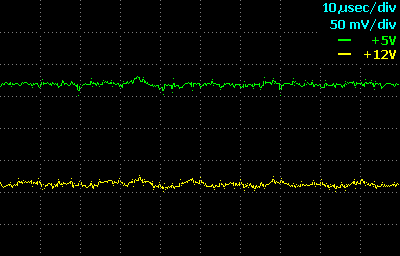
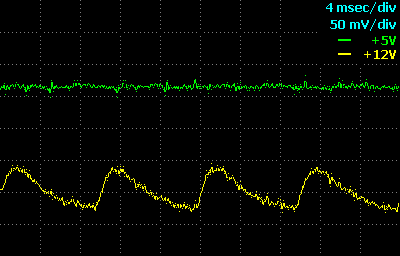
The high-frequency pulsation of the output voltages is negligible (less than 20 millivolts on all the rails), but there is a low-frequency (100Hz) ripple on the +12V rail that is as high as 64 millivolts at full load (the permissible maximum is 120 millivolts). The ripple subsides at lower loads, amounting to 28 millivolts at a combined load of 240W (half the maximum output power of this model).
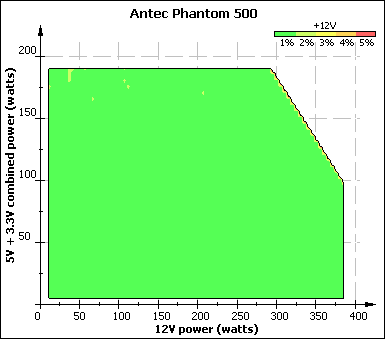
The cross-load diagram of the Phantom 500 doesn’t have as much green as the previous model’s, yet it looks good anyway. The voltages deflect from their nominal values by no more than 4%. The range of loads typical of modern computers (a high load on the +12V and a moderate load on the +5V and +3.3V rails) is all green.
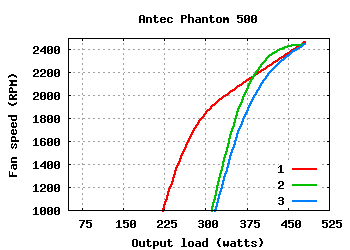
I had to measure the speed of the fan three times, for each of the three positions of the switch. The diagram suggests that only the first and second positions differ much. The third position of the switch doesn’t bring anything dramatically new into the behavior of the fan. In every case, the fan only begins to work when there’s a load of 200-300W on the PSU (I performed my measurements at a room temperature; in a real computer system the fan is going to start up sooner). The speed of the fan is a little over 2400rpm at the maximum.
As a kind of drawback, the fan speed controller doesn’t have some kind of hysteresis between the turn-on and turn-off thresholds. As a result, at a load of about 250-300W the fan periodically turns on and works at about 1400rpm. The PSU receives a portion of fresh air and gets cooler by a few degrees – and the fan turns off again for a couple of minutes. Ideally, the fan turn-off temperature threshold should be lower than its turn-on threshold. There would be no such cycles then. Well, there’s not a high chance that the power consumption of your computer will fit exactly into this range of cyclic turning on of the fan.
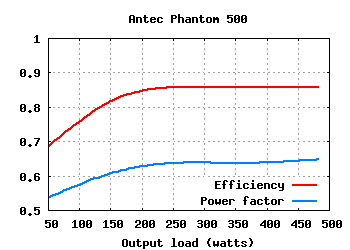
The efficiency of the Phantom 500 reaches 86% at a load of 200W and doesn’t change after that. That’s an excellent result, but quite expectable from a fan-less PSU. It would just overheat otherwise.
The Phantom 500 doesn’t have power factor correction (at least its American version has not – a PSU must have at least passive PFC to be sold in Europe), so its power factor is only 0.65. This also means that you have to manually select the input voltage with a switch (110V or 220V). Be careful when you first turn the PSU on – a wrongly set switch has been the death of a great many power supplies.
Generally speaking, the Phantom 500 is a rather expensive, but interesting option for people who care about silence. This PSU is absolutely silent under low loads. At high loads, its fan is very quiet, too. The other parameters are up to the product class. I have no complaints about the quality of assembly. The stability of the output voltages is excellent. The voltage ripple is within normal. I only wish the manufacturer implemented hysteresis between the thresholds of turning the fan on and off so that it didn’t enter the cycle of turning on/off with a period of several minutes in a certain range of loads.
The TruePower 2.0 looks somewhat unassuming in comparison with the two previous models, especially against the Phantom 500. It seems to be just another gray-colored power supply. Well, its specs don’t promise anything exceptional, either. It is a rather ordinary ATX12V 2.0 model that follows the recent fashion trends and has appropriate certificates, but what model doesn’t have them now?
The actual manufacturer of the power supply is CWT.
You can identify the manufacturer even without looking it up in the UL certificate database, so typical the internal design of this model is. CWT supplies this very model to many trademark holders, so if you put, say, an Antec TruePower and a Foxconn WinFast down next to each other and remove their covers, you will hardly tell what brands they are sold under.
The PSU has a standard internal design except for independent voltage regulation which is represented by the three large toroidal-core chokes of magnetic amplifiers located near the output circuitry. The PSU has neither active nor passive PFC. It is an American model because European PSUs must have some kind of PFC.
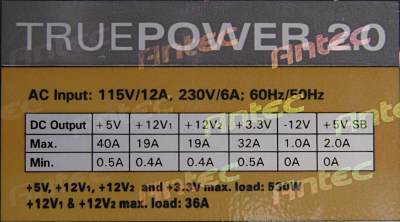
The PSU has a high load capacity of the +12V rail (a maximum current up to 36A with a division into two “virtual” output lines with a maximum of 19A on each) as well as of the +5V rail (as much as 40A, which is almost two times the load capacity of this rail in a majority of today’s ATX12V 2.0 PSUs). The latter can only be of use to owners of old top-end systems in which the old power supply has failed. There were once even dual-processor mainboards that powered the CPUs from the +5V, but the manufacturers soon realized the lack of prospects of that solution.
The PSU is equipped with the following cables and connectors:
The mainboard cable is sleeved. The other cables are just tied up with nylon braces. As the result, wires from different cables may get entangled. Moreover, the different wires in the same cable vary slightly in length.
When the PSU was working in pair with an APC SmartUPS SC 620, loads below 315W were allowable irrespective of the power source (electric mains or batteries). Judging by that, the TruePower is unlikely to have high efficiency.
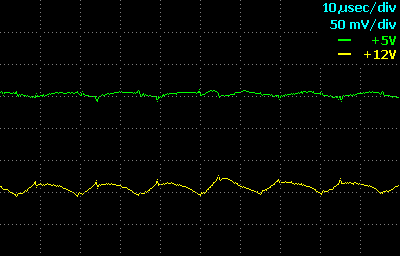
At a load of 530W the output voltage ripple was 20 millivolts on the +5V rail, 31 millivolts on the +12V rail, and 17 millivolts on the +3.3V rail.
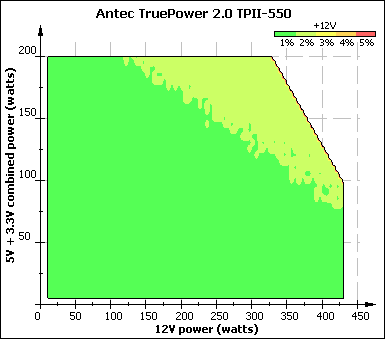
Like a majority of models with independent voltage regulation, the TruePower 2.0 has excellent cross-load characteristics. In the whole range of allowable loads it’s only the +3.3V voltage that goes out of the “green zone”. And even this voltage doesn’t reach the maximum allowable deflection.
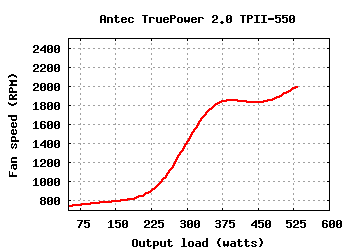
The PSU is cooled with a single Top Motor DF1212BB-3 fan whose speed is nearly constant at loads below 200W, but grows up quickly thereafter until reaches an almost constant level again. The PSU is very quiet at low load, but its fan makes itself heard at speeds higher than 1500rpm.
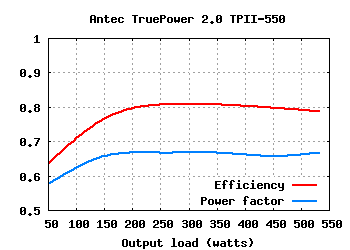
The efficiency is indeed mediocre at about 79% through the most part of the load range. That’s not bad, but worse than many other modern power supplies offer.
The power factor is 0.65 on average, quite expectably for a PFC-less model.
So, the Antec TruePower 2.0 is just a good midrange model. It doesn’t have any exceptional features that would distinguish it from the crowd, but it has no serious defects, either. If you need just a good power supply, you may want to consider the Antec TruePower as an option.
“Green” means the color of the case with Topower’s Silent Green model, but here it means the ecological purity of the product. To be exact, it means high efficiency and compliance with the American Energy Star and the German Blauer Engel programs.
The actual manufacturer of the iGreen Power (and the manufacturer of other CoolerMaster power supplies we’ve tested in our labs so far) is AcBel Polytech (UL# E131875).
The internal design of the PSU is very ordinary, except for the second transformer in the bottom left corner and the two capacitors with different ratings nearby. This transformer proved to be the choke of an active PFC device wound on an E-type instead of a toroidal-type core while the capacitors are connected in parallel so the difference in their capacitances plays no role at all. It was just easier for the PSU designer to make it like that.
Otherwise, it is quite an ordinary modern power supply. It has group voltage regulation; its main PWM and active PFC controllers are implemented with one CM6800G chip.
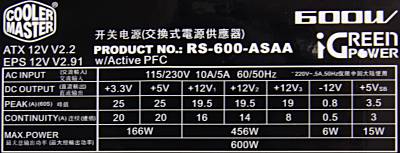
Two columns of parameters are specified for this PSU, for continuous and peak (not longer than 1 minute) loads. The latter thing looks funny for the three +12V outputs which are “virtual” in this PSU, just like in a majority of others. There is only one +12V power rail inside the PSU with a max current of 38A, which is divided into three output lines by 19-19.5A current limiters. Of course, the declaration of a sustained current of 8A and a peak current of 19A for one such output line makes no sense. You can pass a current of 19A through it as long as you want if the combined load on all the three 12V output lines is not higher than 38A.
Judging by the declared load capacity, this is a typical ATX12V 2.2 power supply. This means low allowable currents on the +5V and +3.3V lines because modern computers just don’t need more than that.
When the PSU was working with an APC SmartUPS SC 620, the UPS’s indicator reported overload if there was a load of over 380W on the PSU irrespective of the power source (electric mains or batteries). This is a record-breaking result that is indicative of high efficiency of the PSU as well as of well-designed PFC (not because it corrects the power factor well, but because it works normally with the non-sinusoidal voltage the SC 620 yields from its batteries).
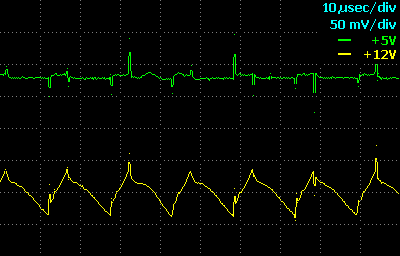
There are narrow surges in the oscillogram of the +5V voltage ripple that occur at the moments when the inverter’s transistors are switched over. Apart from that (and the mainboard is going to filter out most of those surges), the pulsation is low, only 14 milliseconds in amplitude. At full load the voltage ripple was 85 millivolts on the +12V rail (the permissible maximum is 120 millivolts) and 29 millivolts on the +3.3V rail (the permissible maximum is 50 millivolts).
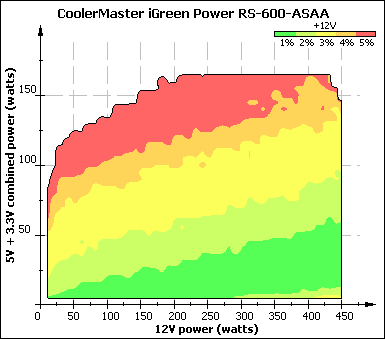
The cross-load diagram doesn’t look that well after we’ve seen diagrams of models with independent voltage regulation. But considering that the power consumption of a typical modern computer falls into the bottom third of the diagram (a low load on the +5V and +3.3V and a high load on the +12V rail), it’s all right here. The PSU’s voltages won’t violate the acceptable limits in a real computer system.
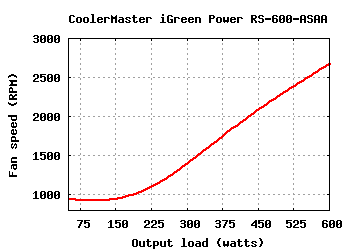
The PSU uses a Protechnic Electric MGA12012HB-O25 fan whose speed is regulated linearly through the entire load (temperature) range, almost. The PSU is of an average quietness. Most users will be quite satisfied with it, but the RS-600-ASAA isn’t exactly silent, because of its intrinsically loud fans from Protechnic Electric that are also rotating at a rather high speed.
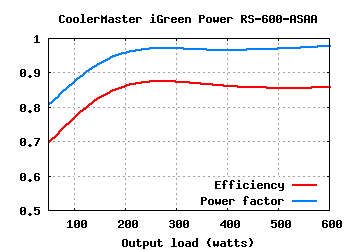
The efficiency of this PSU is an impressive 87% at the max point, but 85-86% at higher loads (well, that’s excellent, too). The power factor is 0.97-0.98 on average.
So, the iGreen Power RS-600-ASAA is a high-quality modern power supply, but it only stands out among similar models with its high efficiency. Although high efficiency means low heat dissipation inside the PSU case and, accordingly, allows to implement a quieter cooling system, this PSU is not quiet. Its fan speed is average.
I can’t definitely tell you what connection exists between memory modules and power supplies, but it is a fact that the module manufacturers have begun to roll out PSUs under their brands, too. I’ve already tested PSUs from OCZ (and will return to them later on in this review), and here is a model from Corsair Memory.
Of course, Corsair is not the actual manufacturer of the PSU. The product is made by Seasonic. The CMPSU-620HX is an intermediary variant between Seasonic’s S-12 and M-12 models. It doesn’t have a second fan (like the M-12 does), but has detachable cables (unlike the S-12).
The innards of this power supply look quite normal to me. There is no reason for the engineers to change the well-established component layout. The only exception is that the high-voltage capacitor, usually located near the left edge of the case, has moved to the center of the PSU whereas the left part is all occupied by an active PFC device, the rectifier’s diode bridge and a line filter.
There is a card with connectors for detachable cables on the rear panel. The soldering is very neat and tidy there.
The PSU uses rather simple heatsinks punched out of an aluminum bar. This may not sound good to some users because many hardware reviewers like to measure the dimensions of heatsinks, transformers and other components. There’s nothing wrong in that, however. The simpler heatsink provides less resistance to the stream of air, so the airflow will be stronger with a same-static-pressure fan (as you know, each fan has not one but two basic parameters: performance describes its ability to work in an open environment whereas static pressure describes its ability to drive a stream of air through an obstacle). As a result, the cooling may prove to be better with smaller heatsinks than with larger ones.
The same goes for the dimensions of the transformers and chokes. They depend on the PSU’s operating frequency (the higher the frequency, the smaller the components, the PSU wattage being the same) and topology. Having a PWM frequency of about 130 kHz and a double-forward topology, the ferrites in the CMPSU-620HX are just the necessary size for normal operation at full power, although they seem small in comparison with older same-wattage PSUs that used to have a half-bridge topology and an operating frequency of 70 kHz.
The PSU is equipped with the following cables and connectors:
The following is enclosed with the PSU:
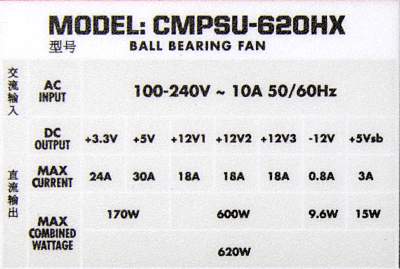
The PSU is declared to have three +12V lines with a max combined current of 50A and a limitation of 18A on each line. However, the PSU manual informs that the lines are united into one when the limitation is exceeded. In other words, there is no actual division of the lines inside the PSU, but the user has already got used to the idea that there must be several 12V outputs, so the manufacturer couldn’t but specify several such lines on the PSU label. Of course, the lack of a “virtual” splitting of the +12V power rail into several output lines has no effect at all on the PSU’s voltage stability or output power.
I checked the PSU out with an APC SmartUPS SC 620, and the UPS’ indicator would report overload at a load of over 365W and 330W when working from the mains and batteries, respectively. Switching to the batteries was performed without problems.
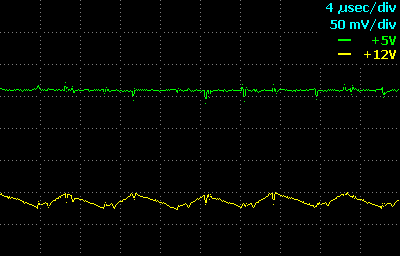
There’s almost no pulsation on the +5V rail at a load of 600W – you can only see small narrow spikes at the moments of switching the inverter’s transistors. At the same load, the voltage ripple was 26 millivolts on the +12V rail and 10 millivolts on the +3.3V rail. There’s only high-frequency pulsation here.
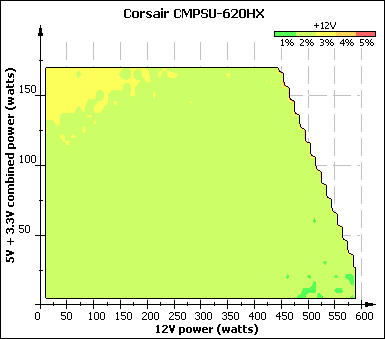
The cross-load characteristics of this PSU look splendid. I’d want to draw your attention to this power supply’s ability to yield nearly full power across the +12V rail only. The +5V voltage is the only one to get near the maximum permissible deflection (red color), but only at those loads that have little to do with modern computers.
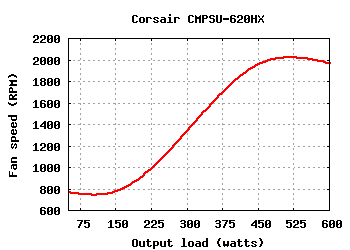
The PSU employs an Adda AD1212HB-A71GL fan whose speed is regulated linearly in most of the load range (from 150 to 450W). The PSU is almost silent at low loads (a fan speed of less than 800rpm) and is quiet at high loads. Although the fan speed is set up with some reserve (the air coming out of the PSU at full load of 600W feels just barely warm), it is lower than that of many other products (e.g. of the above-described CoolerMaster iGreen Power). The use of high-quality fans from Adda contributes to the PSU’s quietness, too. But running a little ahead, I should confess that the Corsair is not the quietest PSU on the market. S-12 series models selling under Seasonic’s own brand are quieter still. On the other hand, the CMPSU-620HX is going to satisfy a vast majority of users with its noise characteristics, too.
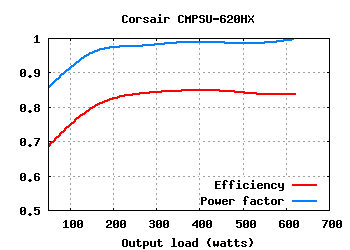
The PSU efficiency is 85% at the maximum and 84% at full load. That’s a very good result, quite accurately coinciding with the specification. The power factor is 0.99 on average.
Corsair Memory has made a successful debut on the PSU market. The CMPSU-620HX doesn’t have any apparent drawbacks. It is a high-wattage model with excellent parameters, particularly very quiet at work. If its 620W wattage is excessive for your system (I guess it is excessive for a majority of today’s PCs), you may want to consider its 520W analog, the CMPSU-520HX model.
Sirtec, the producer of the High Power series of power supplies, is well known to our readers because its products can be met under the brands of Thermaltake, Chieftec and many others. The HPC-560-A12S differs from the other PSUs in this review with its power consumption indicator called Power Watcher.
It’s all quite ordinary inside, with group voltage regulation and active PFC. As opposed to the Corsair model, the heatsinks are large, with numerous small ribs and cross cuts. Let’s see if this helps cool the PSU better.
The component layout is similar to that of the Thermaltake W0083 (PurePower 600AP) that I described in one of my previous reviews. Some of the PSU electronics are installed on a card that is placed vertically along the rear panel.
The power consumption indicator is located on the rear panel of the case. It is a 3-position 7-section red-colored indicator. I found out that at loads over 100W the indicator’s reading was about 10% lower than the real value. Well, I guess its accuracy varies from sample to sample because the manufacturer can hardly regard it as a serious measuring instrument.
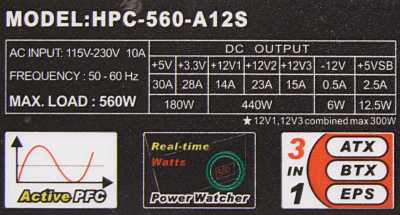
The PSU complies with the ATX12V 2.2 standard. The maximum combined load current on the +12V rail is a little lower than 37A. The lines are separated virtually, as usual. That is, there is only one +12V rail inside it with an allowable current of 37A. That’s why the purpose of specifying (in the footnote) the max combined output power for two of the three output lines is unclear. Besides that, the PSU doesn’t formally comply with the EN-60950 standard because the max output power on the 12V2 line is 276VA. This is more than 240VA which is the maximum permitted by that standard. But as I have repeatedly written in my reviews, this does not affect the stability of a computer’s operation in any way.
The PSU is equipped with the following cables and connectors:
So, this power supply allows powering two additional system fans from the PSU’s own speed controller. That is, the speed of the fans will depend on the temperature inside the PSU. This is a nice feature, but all modern mainboards, including microATX ones, can control the speed of system fans anyway.
When the power supply was working in pair with an APC SmartUPS SC 620, the UPS would report overload at loads of over 365W and 315W (electric mains and batteries, respectively). Switching to the batteries was performed without problems, though. This difference is due to the PSU’s active PFC. It’s clear that it doesn’t cope well with the non-sinusoidal voltage supplied by the UPS’ batteries.
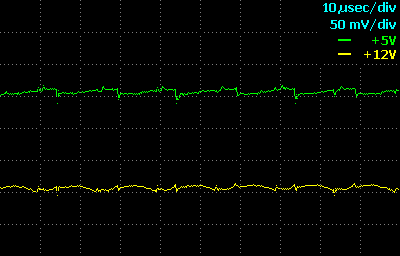
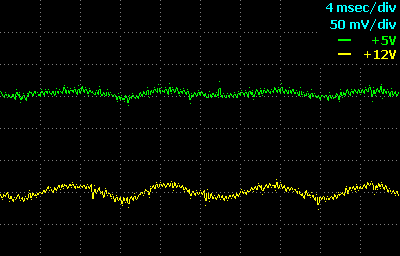
At a load of 550W, the output voltage ripple amounted to 27 millivolts on the +5V rail, to 40 millivolts on the +12V rail, and to 9 millivolts on the +3.3V rail. There’s both low- and high-frequency pulsation here.
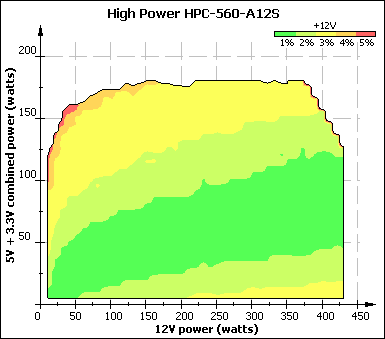
The PSU doesn’t have additional independent voltage regulation, yet its cross-load diagram is limited but in a very small part with the voltages going out of the acceptable limits. This occurs when there’s high load on the +5V rail which is unimportant for today’s computer systems. So, this regulation of voltages should be considered good.
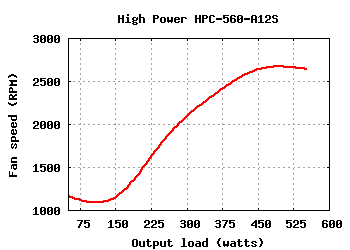
The PSU is equipped with a Hong Sheng A1225S12D fan and is rather loud at work. At min load the fan speed is about 1200rpm, which is already not very low. At a load of 270W it is 2000rpm. For comparison, the fan of the above-described PSU from Corsair only reached that speed at full output power (600W). The fans of the Seasonic S-12 and the Zalman PSUs to be described below do not reach that speed at all! So, pretty-looking heatsinks do not guarantee quiet cooling.
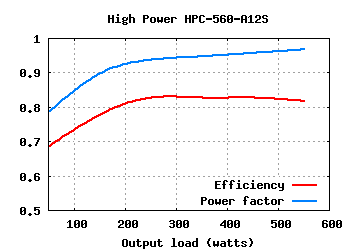
The efficiency of this PSU is about 83%. That’s an excellent, even though not record-breaking, result. The PFC device is not that good, the power factor barely reaching 0.97. However, a power factor difference of a few percent doesn’t matter much in practice. To comply with the rather strict requirements of the Energy Star 2007 standard it is only necessary to have a power factor of higher than 0.90 at full load.
So, the HPC-560-A12S is a good power supply with one obvious drawback. It is rather noisy even at minimum load. If this doesn’t scare you, the PSU is going to be a good choice. Otherwise, you should consider alternative products or replace the PSU’s native fan with a slower and quieter one (judging by the low temperature of the exhausted air, there won’t be overheat problems after that).
To be continued!